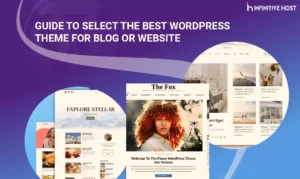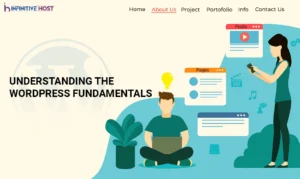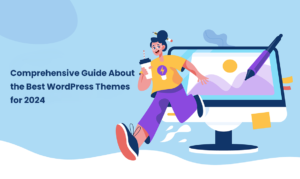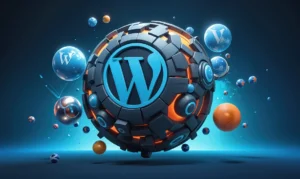Table of Contents
Are you frustrated of your WordPress site’s slow loading times and bad user experience? The user experience is important when it comes to increasing conversion rates or rising search engine ranks.
You may have already installed several suggested WordPress speed and optimization plugins for a better user experience, but there’s more to it – the illusive Core Web Vitals.
But what exactly are they? Why are they so important? And how can you make them better for your WordPress site?
If you’re having trouble getting your website to rank on the first page of Google, this article will help you understand how Core Web Vitals and SEO may help you.
What is the importance of core web vitals?

Core Web Vitals and SEO are important since they assess user engagement and are directly related to the website experience. A pleasant visitor experience increases behaviors such as subscribing, purchasing, or inquiring. Slow loading speeds may cause users to leave your site.
Core Web Vitals is a ranking criteria considered by Google that influences search engine placement. The higher your website ranks, the better the user experience.
Google focuses excellent results for consumers, emphasizing the relevance of analytics for user experience. Here’s why the Core Web Vitals ranking element is important!
| Study Highlights | Impact on Metrics |
| Cloudways supported WP Bullet in achieving flawless Google Core Web Vitals and over 90 PageSpeed Insights ratings. | Client satisfaction has increased. |
| Page abandonment was decreased by 24% when the Core Web Vitals standards were met. | User engagement: The bounce rate has been reduced. |
| The Core Web Vitals enhancement by Netzwelt resulted in 18% greater ad income and 27% more page visits. | Increased advertising and engagement. |
| Farfetch’s conversion rate increased by 1.3% with every 100ms LCP decrease. | Increased web conversions for the company. |
| By lowering CLS from 1.65 to 0, redBus improved its worldwide domain ranking. | SEO: Improved domain ranks |
| A 0.2 drop in CLS resulted 15% more page visits, 13% longer sessions, and a 1.72% reduced bounce rate for Yahoo! JAPAN. | Improved session analytics have increased user engagement. |
What is the Core Web Vitals Passing Score?
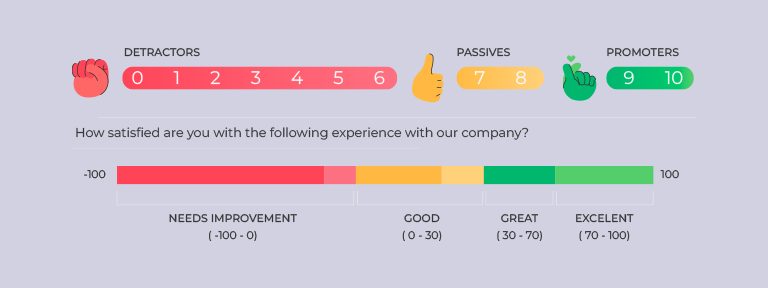
| Good | Need Improvement | Poor | |
| LCP | <=2.5s | <=4s | >4s |
| FID | <=100ms | <=300ms | >300ms |
| CLS | <=0.1 | <=0.25 | >0.25 |
| INP (experimental) | <=200ms | <=500ms | >500ms |
Note: Interaction to Next Paint (INP), a new Core Web Vital measure, will take the place of First Input Delay (FID) beginning in March 2024.
What Are the Effects of Core Web Vitals on SEO?
The Page Experience Update, rolled out by Google in February-March 2022, focuses on improving the user experience by considering factors like secure browsing, mobile-friendliness, HTTPS usage, a lack of intrusive interstitials on mobile devices (Ad Experience), and Core Web Vitals. Initially subtle, its impact became evident over time, as businesses realized that investing in performance optimization led to faster pages, better user experiences, higher conversions, and improved Google rankings.
In 2023, Google is placing even more emphasis on Page Experience for SEO. Recent updates and industry developments indicate changes to the Page Experience report in Search Console. This report will evolve into a new page connecting to comprehensive guidance on the page experience. Users can also expect a dashboard view with individual Core Web Vitals and HTTPS reports, all available within the Search Console.
How to Get Your Site Ready for SEO Rankings
Google is evolving its website ranking criteria, with the Page Experience update. Starting December 1, 2023, Google will retire tools like the “Mobile Usability” report, the Mobile-Friendly Test, and the Mobile-Friendly Test API. While mobile usability remains crucial, you can now assess your site’s mobile-friendliness more effectively using Chrome’s Lighthouse tool.
In April 2023, Google changed its focus to prioritize user-friendliness, emphasizing fast loading, mobile compatibility, and user navigation. Google recommends using tools like the Page Experience report in Google Search Console to assess and enhance your website.
The Page Experience report is also undergoing changes, providing general advice on improving user satisfaction rather than specific details. This aims to enhance the user experience and boost your site’s visibility in search results.
If you have a WordPress website, it’s essential to adapt to the April update by:
- Selecting a streamlined theme for fast loading and mobile-friendliness.
- Optimizing images for smaller sizes and faster loading times.
- Implementing caching tools to speed up your site.
- Addressing JavaScript and CSS issues to improve page loading speed.
- Considering a Content Delivery Network (CDN) like Cloudflare CDN for faster loading, especially for distant users.
- Prioritizing the loading of essential content to improve the Largest Contentful Paint score.
- Being mindful of JavaScript usage to prevent site slowdowns.
Remember that aligning your website with Google’s updates isn’t just about pleasing Google; it’s about enhancing the user experience. By doing so, Google will reward you with better rankings.
Exploring the Toughest Web Vitals Metrics for Improved Performance

Now, let’s dive into the intricate details of performance improvement. Fixing Core Web Vitals isn’t a simple task, especially when your website contains a substantial amount of content. Among these critical Core Web Vitals metrics, one stands out as particularly challenging – Time to First Byte (TTFB).
TTFB measures the server’s response time, and ensuring a fast and prompt response can be quite demanding, especially depending on your website’s underlying framework.
This challenge becomes more pronounced, particularly for eCommerce websites. These platforms often feature dynamic and frequently changing pages, making it challenging to implement effective caching strategies. Moreover, extensive product catalogs can further complicate matters, ultimately affecting the Time to First Byte.
Another complex aspect is the Largest Contentful Paint (LCP). This metric assesses loading performance by gauging how swiftly the primary content of a page becomes visible. Achieving optimal LCP scores can be a formidable task, requiring meticulous attention and optimization efforts.
Cumulative Layout Shift (CLS) poses unique challenges for certain individuals. CLS assesses a page’s visual stability by quantifying unexpected layout shifts. This can be particularly intricate to address, especially for established websites with numerous resources and dependencies. In such cases, rectifying inefficient loading of assets like JavaScript files and fonts, and managing render-blocking assets, becomes key in achieving favorable CLS scores.
Effectively addressing these challenges can significantly enhance SEO performance and ensure a more seamless user experience.
Keep in Mind and Avoid These Mistakes When Optimizing Core

Let’s find out the crucial considerations and common pitfalls to avoid when optimizing Core Web Vitals to enhance SEO performance.
Prioritize Key Techniques
Improving Core Web Vitals involves several pivotal techniques:
- Lazyloading: Optimize your site by loading content as users scroll, reducing initial load times.
- Preloading: Preloading involves predicting user interactions and proactively loading vital resources to expedite rendering.
- Inline Critical CSS: Embed critical CSS directly into HTML to expedite rendering.
- Rendering First Visible Content: Prioritize loading initially visible content for a smoother user experience.
Mind the Fonts
Fonts have a significant impact on site performance. Efficient font loading entails considering font families, styles, glyph sets, and loading methods. Balancing preloading and browser-specific formats is essential.
Overlooked Optimization
Defer JavaScript optimization is often overlooked but can significantly improve Google PageSpeed Insights (GPSI) scores.
Tackle TTFB and Server-Side Scripts: Addressing Time to First Byte (TTFB) is crucial. Enhance server-side scripts like PHP or SQL to positively influence TTFB. Use caution when choosing page builders, themes, or plugins to improve all Core Web Vitals metrics.
Consistent Improvement
Achieving a lightweight, responsive, and speedy website is an ongoing endeavor. It’s essential to consistently apply best practices like page caching, GZIP or Brotli compression, and image optimization to uphold optimal page loading times.
Avoid Common Mistakes:
When striving for SEO excellence, be cautious of these pitfalls:
- Home Page Focus: Extend your page speed improvements beyond just the homepage to ensure a comprehensive Page Experience across your entire website.
- Image Size Optimization: Pay close attention to image sizes and avoid uploading oversized images that can negatively impact loading times.
- Prioritize SEO: Make SEO a priority during the web design process to avoid undermining your rankings.
- Managing Permalink Changes: Be prudent when altering permalink structures or relocating/deleting assets. Implement appropriate redirects to prevent disruption.
- UX Impact: Be mindful of HTTP status errors, broken links, and intrusive pop-ups, as they can harm the user experience and affect both users and rankings.
- Enhance User Experience: Create a positive user experience by avoiding intrusive pop-ups and interstitials that disrupt browsing. Maintain website security by avoiding the use of pirated themes or plugins and promptly addressing any potential security vulnerabilities.
How to Select the Best Tools to Measure Speed and SEO Performance
When it comes to assessing the speed and SEO performance of your WordPress website, several dependable tools are highly recommended. Here’s a list of essential tools to consider:
Google Page Speed Insights and Lighthouse
Google Page Speed Insights, along with Lighthouse and Lighthouse’s Scoring Calculator, are fundamental tools for evaluating your site’s performance. They offer comprehensive feedback on Core Web Vitals and provide suggestions for enhancements.
GTmetrix
GTmetrix, which now integrates Lighthouse metrics, is another valuable choice. It offers a quick and straightforward analysis of your site and provides a historical perspective on any changes you’ve made. It’s especially helpful for addressing server response time issues.
Chrome Developer Tools
Devtools, or developer tools, aid in inspecting, testing, and debugging code affecting browser UI. Marketers, SEO experts, and designers utilize them for webpage optimization. For in-depth audits and identifying optimization opportunities, Chrome’s ‘Network’ tab is a valuable resource. It provides a detailed view of the elements loaded by the browser, aiding in performance optimization.
WebPageTest
WebPageTest is a powerful tool that provides detailed insights into various performance aspects, including First Byte Time, CDN usage, and web vitals scores.
Sucuri SiteCheck
This free tool is invaluable for verifying your website’s security. It scans for malware and confirms its safe browsing status.
Google’s Mobile-Friendly Test Tool
When assessing mobile compatibility, Google’s Mobile-Friendly Test tool is a user-friendly and highly effective option.
Pingdom
Pingdom is another valuable tool for monitoring the speed and performance of your website. It provides insights into your site’s loading times and identifies areas that need improvement.
By making use of the tools mentioned above, you can effectively gauge the speed and SEO performance of your WordPress site.
The Essential Tips to Improving Web Vitals on WordPress
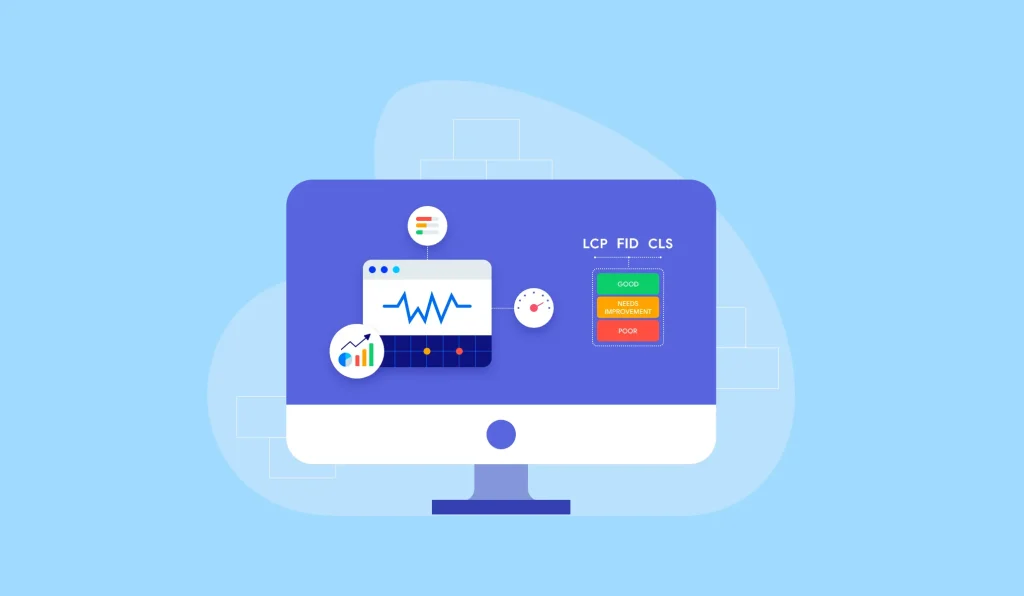
Now that you have a solid understanding of your website’s performance, let’s explore ways to boost your WordPress Core Web Vitals:
Install Core Web Vitals Plugin:
A straightforward approach is to use a free Core Web Vitals WordPress plugin like Jetpack Boost. It simplifies complex optimizations with easy toggles.
Here’s how to get started:
- Navigate to your WordPress dashboard’s Plugins section and select the option “Add New.”
- Search for Jetpack Boost and click Install Now, then Activate.
- Head to Jetpack and select Boost. Click the green Get Started button.
- Jetpack will assess your website’s current performance score.
Apart from Jetpack Boost, other useful plugins like Smush for image optimization and Autoptimize for streamlining CSS, JavaScript, and HTML files can further enhance your site’s performance when used alongside Jetpack Boost.
Choose Reliable Hosting:
Your choice of hosting provider plays a vital role in your website’s performance. Opt for a reputable host with fast server response times, SSD storage, and server-level caching for quicker site loading.
Prioritize server response times below 200ms and seek SSD storage for faster data access. Server-level caching reduces server load and enhances speed.
Consider the geographical location of your hosting provider’s data centers in relation to your target audience to minimize latency and improve the overall user experience. Managed WordPress hosting, tailored for WordPress websites, outperforms shared hosting.
For a hosting solution that meets these criteria and more, consider Cloudways. It includes a pre-installed Breeze cache plugin with your WordPress installation and Varnish cache integration for improved Core Web Vitals scores. You can see an impressive example of Cloudways’ performance in our fastest WordPress hosting blog, achieving a remarkable 79ms Load Time.
Use a Lightweight Theme
Selecting a well-optimized theme is crucial for a fast-loading website. To make the right choice:
Opt for a minimal, performance-focused theme to avoid excessive features, bloated code, and too many HTTP requests.
Consider these theme selection tips:
- Analyze the theme’s demo performance using tools like Google PageSpeed Insights or GTmetrix to assess its potential on your site.
- Give preference to themes that emphasize efficient code, minimize JavaScript usage, and offer responsive design support.
- Test the theme’s performance on a test site with your plugins and content to ensure it meets your requirements.
Compress Your Images
Images can significantly impact a website’s loading speed. To improve image performance:
- Choose appropriate image formats like WebP, JPEG XR, or AVIF for better compression and quality.
- Implement lazy loading to delay off-screen image loading, reducing initial page load times.
- Compress and resize images using tools such as TinyPNG or Imagify, or utilize top WordPress image optimization plugins.
- Enhance loading speed by installing a CDN like Cloudflare CDN to deliver images from nearby servers. Cloudways users can activate the Cloudflare Enterprise CDN add-on for Enterprise-level CDN features.
Minify CSS and JavaScript Files
CSS and JavaScript files play a significant role in your website’s loading speed.
To optimize them:
- Minify and Compress: Speed up your website by reducing CSS and JavaScript file sizes through minification and compression. This enhances overall performance. Services like Cloudflare Polish and Cloudflare Mirage can also optimize site images for faster loading.
- Combine and Inline: Minimize requests by combining multiple CSS or JavaScript files into one. Additionally, directly inline critical CSS and JavaScript into HTML to reduce separate requests.
- Remove Render-Blocking Resources: Identify resources that delay page rendering, like large CSS or JavaScript files loaded before content. Remove or optimize these resources to speed up page visibility.
Implement Server-Side Improvements
Server-side optimizations are crucial for improving your site’s performance.
To achieve this:
- Compression: Activate GZIP or Brotli compression on your server to reduce file sizes and speed up transfers. Typically, this can be configured through your server’s settings.
- Cache Setup: Implement server-level caching and cache-control headers to ease server load. This may involve adjusting server configuration files or using plugins like Breeze.
- Consider a Reverse-Proxy: Explore a reverse-proxy setup such as NGINX or Varnish. This configuration optimizes performance by caching content and distributing workloads across multiple servers, improving scalability and responsiveness.
Minimize the Utilization of Add-Ons
When dealing with plugins, thoughtful selection is essential. Each plugin introduces additional load to your webpage, which can impact overall performance. It’s advisable to keep only the essential plugins that serve a clear purpose.
Additionally, following Google’s recommendation, strive for a server response time of less than 600 milliseconds. This reflects the speed at which your server responds to requests, enhancing the user experience.
Optimize WordPress Database
Optimizing your WordPress database enhances performance by eliminating unnecessary data and reducing its size.
Here are the steps for effective database optimization:
- Clean Unnecessary Data: Use tools like phpMyAdmin to remove revisions, spam comments, and transients.
- Automate Maintenance: Maintain efficiency by employing top WordPress backup plugins like UpdraftPlus for automated database cleanup.
- Regular Backups: Ensure data security by regularly backing up your database. Cloudways offers automated backups with customizable frequencies, ranging from hourly to weekly.
Consider using SnapShooter, an affordable offsite backup solution. In partnership with DigitalOcean, SnapShooter offers an exclusive 20% discount to Cloudways customers for the first 3 months on all monthly payment plans.
Set up WordPress Cron Jobs
WordPress cron jobs are background tasks responsible for managing actions like plugin updates, scheduled post publication, and email notifications. Optimizing these tasks can improve your site’s performance.
To optimize WordPress cron jobs:
- Disable Default Cron: Increase efficiency by deactivating the default WordPress cron system.
- Add define(‘DISABLE_WP_CRON’, true); to your wp-config.php file.
- Additionally, schedule resource-intensive tasks during low-traffic periods, such as overnight or on weekends, to minimize their impact on performance.
Wrapping Up
And there you have it! You should now be well-equipped to optimize your website for the Google Page Experience Update. Improving your Core Web Vitals scores may present challenges, with various web performance techniques, some more complex and time-consuming than others, needed.
Nevertheless, attaining a favorable score is entirely achievable. This article has provided you with insights from nine valuable tips that lead the way to success.
Now, it’s time to put your newfound knowledge of Core Web Vitals and SEO into practice. If you encounter any obstacles along the way, don’t hesitate to reach out in the comments.
Also Read :- What Is WP-Staging Plugin For WordPress?




